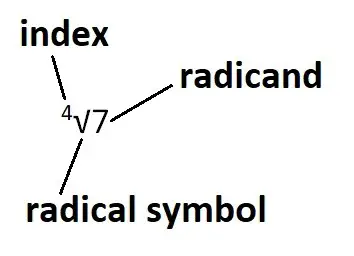Adding, multiplying and dividing square roots are important skills for algebra, geometry, and calculus courses. The rules are a little different for each of these three operations, though.
So, what do you need to know about adding, multiplying, and dividing square roots? To add square roots, we need like radicals (which have the same radicand, or number under the radical). To multiply or divide square roots, we simplify by factoring out perfect squares (like 4, 9, 16, etc.) from the resulting radicand. In some cases, we may also need to rationalize the denominator.
Of course, it helps to know your perfect squares and how to factor numbers quickly so that you can simplify square roots faster.
In this article, we’ll talk about adding, multiplying, and dividing square roots. We’ll mention how to identify like radicals for adding, how to factor out perfect squares from the radicand, and how to rationalize denominators.
Let’s get started.
Adding Square Roots
When adding square roots, we always want to look for like terms. Sometimes these like terms will be obvious, and other times we will need to do a little work to simplify and reveal “hidden” like terms.

Like Radicals
When adding square roots, “like radicals” are like terms that contain the same radical. That is, both terms contain the same radicand (value under the radical symbol).
For example:
- 5√3 and 6√3 are like radicals – they have the same radicand (which is 3) and the same index (which is 2; when no index is written for a radical, we assume an index of 2).
- √3 and √5 are not like radicals – even though they have the same index (which is 2), they also have different radicands (3 and 5).
When we add like radicals a√c + b√c, we get (a+b)√c.
(Note: when subtracting radicals, it is similar: a√c – b√c, gives us (a-b)√c.
For example, 2√3 + 4√3 = (4+2)√3 = 6√3.
As mentioned earlier, we sometimes need to simplify radicals to find out if we have like radicals.
For example:
- We can simplify √12 to √(4*3) = (√4)(√3) = 2√3. So √12 and 5√3 are actually like radicals.
- We can simplify √50 to √(25*2) = (√25)(√2) = 5√2. So √50 and 6√2 are actually like radicals.
So, the key is to factor out perfect squares (such as 4, 9, 16, 25, etc.) to simplify a square root (a radical with an index of 2).
Let’s look at some examples of how to add square roots, starting with simple ones and working up to more advanced examples.
Example 1: Adding Square Roots
Let’s say we want to add 4√3 + 5√3.
Since both radicands are 3, we have like radicals. So, we can add them as usual:
- 4√3 + 5√3
- =(4+5)√3
- =9√3
Example 2: Adding Square Roots
Let’s say we want to add 6√2 + 7√2 + 8√2.
Since all three radicands are 2, we have like radicals. So, we can add them as usual:
- 6√2 + 7√2 + 8√2
- =(6+7+8)√2
- =21√2
Example 3: Adding Square Roots
Let’s say we want to add 6√2 + 7√3 + 8√5
Since all three radicands are different (and they cannot be simplified), we do not have like radicals. So, we cannot combine them or simplify the sum any further.
Example 4: Adding Square Roots
Let’s say we want to add 5√2 + 12√8 + 3√4.
The radicands are different, but we can simplify them:
- √8 = √(4*2) = √4*√2 = 2√2
- √4 = 2
Now we can rewrite the sum as:
- 5√2 + 12√8 + 3√4
- =5√2 + 12(2√2) + 3(2)
- =5√2 + 24√2 + 6
Since the first two radicands are 2, we have like radicals. So, we can add them as usual:
- 5√2 + 24√2 + 6
- =(5+24)√2 + 6
- =29√2 + 6
We cannot combine the 6 with the square root of 2 term, so we are done simplifying.
Example 5: Adding Square Roots
Let’s say we want to add √3 + 5√12 + 7√27 + 11√75
The radicands are different, but we can simplify them:
- √12 = √(4*3) = √4*√3 = 2√3
- √27 = √(9*3) = √9*√3 = 3√3
- √75 = √(25*3) = √25*√3 = 5√3
Now we can rewrite the sum as:
- √3 + 5√12 + 7√27 + 11√75
- =√3 + 5(2√3) + 7(3√3) + 11(5√3)
- =√3 + 10√3 + 21√3 + 55√3
Since the radicands are all 3, we have like radicals. So, we can add them as usual:
- √3 + 10√3 + 21√3 + 55√3
- =(1 + 10 + 21 + 55)√3
- =87√3
Example 6: Adding Square Roots
Let’s say we want to add √24 + 5√54 + √96.
The radicands are different, but we can simplify them:
- √24 = √(4*6) = √4*√6 = 2√6
- √54 = √(9*6) = √9*√6 = 3√6
- √96 = √(16*6) = √16*√6 = 4√6
Now we can rewrite the sum as:
- √24 + 5√54 + √96
- =2√6 + 5(3√6) + 4√6
- =2√6 + 15√6 + 4√6
Since the radicands are all 6, we have like radicals. So, we can add them as usual:
- 2√6 + 15√6 + 4√6
- =(2 + 15 + 4)√6
- =21√6
Multiplying Square Roots
When multiplying square roots, we do not need like terms. All we need to do is follow this formula:
- √a√b = √ab
For example, √2√3 = √(2*3) = √6.
We can extend this formula to include coefficients outside the square roots:
- (a√c)*(b√d) = ab√cd
For example, (2√5)*(3√7) = (2*3)√(5*7) = 6√35.
The key thing to remember after multiplying square roots is that we might need to simplify. As we saw earlier, the key is to factor out perfect squares (such as 4, 9, 16, 25, etc.)

Let’s look at some examples to see how it works.
Example 1: Multiplying Square Roots
Let’s say we want to multiply (√5)*(√6).
Using the formula, we get:
- (√5)*(√6)
- =√(5*6)
- =√(30)
There is no perfect square that is a factor of 30 (other than 1), since 4, 9, 16, 25, etc. do not divide 30 evenly.
So, we have simplified as far as possible.
Example 2: Multiplying Square Roots
Let’s say we want to multiply (√6)*(√10).
Using the formula, we get:
- (√6)*(√10)
- =√(6*10)
- =√(60)
There is a perfect square that is a factor of 60 (other than 1), which is 4. So, we will factor it out to simplify:
- √60
- =√(4*15)
- =√4*√15
- =2√15
There is no perfect square that is a factor of 15 (other than 1), since 4, 9, 16, 25, etc. do not divide 15 evenly.
So, we have simplified as far as possible.
Example 3: Multiplying Square Roots
Let’s say we want to multiply (√30)*(√105).
Using the formula, we get:
- (√30)*(√105)
- =√(30*105)
- =√(3150)
We can use a factor tree to simplify 3150, and it comes out to:
- 3150
- =2*1575
- =2*3*525
- =2*3*3*175
- =2*3*3*5*35
- =2*3*3*5*5*7
So, the perfect squares 9 (3*3) and 25 (5*5) both divide 3150 evenly. So, we can factor them out:
- √3150
- =√9*25*14
- =√9*√25*√14
- =3*5*√14
- =15*√14
There is no perfect square that is a factor of 14 (other than 1), since 4, 9, 16, 25, etc. do not divide 14 evenly.
So, we have simplified as far as possible.
Example 4: Multiplying Square Roots
Let’s say we want to multiply (√2)*(√3))*(√5)
Using the formula, we get:
- (√2)*(√3))*(√5)
- =√(2*3*5)
- =√(30)
There is no perfect square that is a factor of 30 (other than 1), since 4, 9, 16, 25, etc. do not divide 30 evenly.
So, we have simplified as far as possible.
Dividing Square Roots
When dividing square roots, we do not need like terms. All we need to do is follow this formula:
- √a/√b = √(a/b)
For example, √6/√2 = √(6/2) = √3.
We can extend this formula to include coefficients outside the square roots:
- (a√c)/(b√d) = (a/b)√(c/d)
For example, (15√12)/(3√4) = (15/3)√(12/4) = 5√3.
The key thing to remember after dividing square roots is that we might need to simplify. As we saw earlier, the key is to factor out perfect squares (such as 4, 9, 16, 25, etc.)

Also, we generally want to rationalize the denominator so that there is no square root in the denominator (but there can be a square root in the numerator).
Rationalize A Denominator
To rationalize a denominator of the form a√b, simply multiply the fraction by √b on the top and bottom.
For example, to rationalize 2/√3, we multiply by √3 on the top and bottom to get 2*√3/√3*√3 = 2√3/3.
Let’s look at some examples of how to divide square roots. Some of the examples will require us to simplify or rationalize denominators.
Example 1: Dividing Square Roots
Let’s say we want to divide (√30)/(√10).
Using the formula, we get:
- (√30)/(√10)
- =√(30/10)
- =√(3)
There is no perfect square that is a factor of 3 (other than 1), since 4, 9, 16, 25, etc. do not divide 3 evenly.
So, we have simplified as far as possible (there is no radical denominator to rationalize).
Example 2: Dividing Square Roots
Let’s say we want to divide (√40)/(√10).
Using the formula, we get:
- (√40)/(√10)
- =√(40/10)
- =√(4)
- 2
Since we got an integer result, we have simplified as far as possible (there is no radical denominator to rationalize, and no radical to simplify).
Example 3: Dividing Square Roots
Let’s say we want to divide (√240)/(√20).
Using the formula, we get:
- (√240)/(√20)
- =√(240/20)
- =√(12)
- =√(4*3)
- =√4*√3
- =2√3
We have simplified as far as possible (there is no radical denominator to rationalize, and the square root of 3 has no perfect square factors other than 1).
Example 4: Dividing Square Roots
Let’s say we want to divide (50√2)/(20√12).
Using the formula, we get:
- (50√2)/(20√12)
- =(50/20)√(2/12)
- =(5/2)√(1/6)
- =2.5*(√1/√6)
- =2.5*(1/√6)
- =2.5/√6
Now we can simplify by rationalizing the denominator. We just have to multiply by √6 on the top and bottom:
- 2.5/√6
- =(2.5*√6/√6*√6)
- =(2.5*√6/6)
- =(2.5/6)*√6
- =(5/12)*√6
- =5√6/12
This is simplified as far as possible.
Conclusion
Now you know how to add, subtract, multiply, and divide square roots. You also know how to simplify an expression with square roots and rationalize a denominator.
You can find out how to calculate square roots by hand here.
See some of the uses of square roots here.
You can learn the answers to common questions about square roots here.
I hope you found this article helpful. If so, please share it with someone who can use the information.
Don’t forget to subscribe to our YouTube channel & get updates on new math videos!


